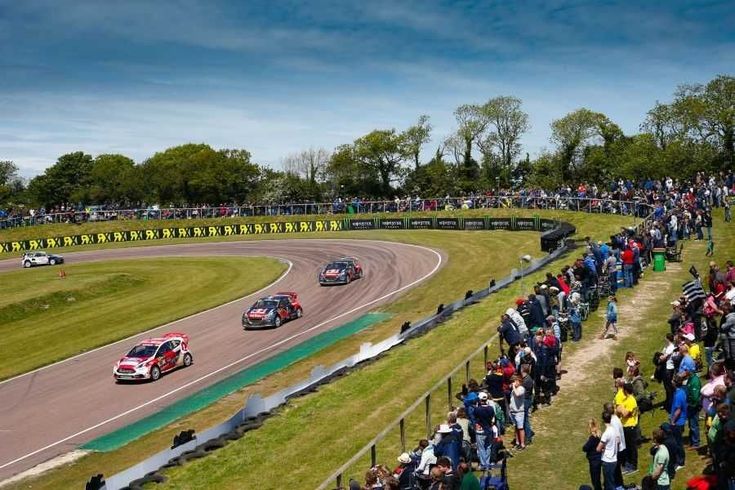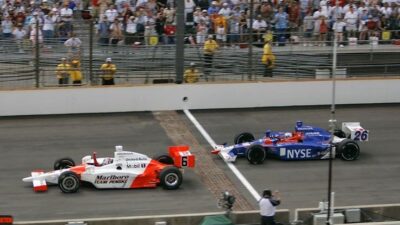Racing has always been a cornerstone of American motorsports culture, but many legendary tracks that once hosted thrilling competitions have disappeared from the landscape. These former racing venues tell important stories about the evolution of motorsports and the challenges facing the racing industry over several decades.
Numerous tracks across North America have been shuttered over time, including facilities that were once considered top-class venues in major racing states. From speedways in North Carolina and Pennsylvania to iconic California circuits, these closed tracks represent different eras of racing history. Understanding why these venues closed and examining their lasting impact helps explain how the racing world has changed and what factors continue to shape the sport today.
1) Rockingham Speedway, North Carolina
Rockingham Speedway opened in 1965 as North Carolina Motor Speedway. The track sits in North Carolina’s Sandhills region and measures 0.94 miles around.
Richard Petty won the pole position for the first race in 1965. Curtis Turner claimed the victory in that inaugural event.
The speedway became a crucial part of NASCAR’s Southeast backbone alongside tracks like Darlington and Martinsville. It hosted two Cup Series races each year for decades.
Financial problems led to the track’s decline in the early 2000s. NASCAR removed one of its two annual races, then eliminated racing there completely.
Rockingham held its last Cup Series race on February 22, 2004. The final race failed to sell out despite speculation it would be the last.
The track received $9 million in federal funding and began repaving in recent years. Hope remains for the speedway’s return to major racing.
2) Nazareth Speedway, Pennsylvania
Nazareth Speedway was a historic auto racing facility in Lower Nazareth Township in Pennsylvania’s Lehigh Valley region. The track operated from 1910 to 2004.
The speedway began as a horse racing track in the 1850s at the Northampton County Agricultural Fairgrounds. A new half-mile track was constructed at its current location between Routes 191 and 248 in the early 1900s.
Motor racing events started in the 1910s. The track went through various changes over the decades, including bankruptcy in the early 1970s.
New owners bought the facility for $480,000 in the 1980s. The track was renamed Nazareth Speedway in 1993.
NASCAR’s unique five-turn layout made it stand out. The track was repaved in 1987 and measured slightly less than a mile.
After the 2004 race, the Indy Racing League dropped Nazareth from its schedule. The track now sits abandoned and fenced off, with grandstands moved to other facilities.
3) Ontario Motor Speedway, California
The Ontario Motor Speedway was a copy of the Indianapolis Motor Speedway, located in California. This earned it the nickname “Indianapolis of the West.”
The track opened in 1968 and closed in 1980. It operated for only about 12 years.
Ontario was the first track to host major racing events on the West Coast. The facility featured both an oval track and a road course.
Financial problems plagued the speedway from the beginning. The track was over leveraged financially from the start. No one could see how it would survive.
Horrible management plus a growing need for commercial space put an end to the facility. Chevron purchased it in December 1980 and it went defunct with no more races after 1980.
The site was eventually developed for commercial use, ending another chapter in California’s racing history.
4) Riverside International Raceway, California
Riverside International Raceway was established in 1957 in the Edgemont area of Riverside County. The track sat 50 miles east of Los Angeles in the foothills of the San Bernardino mountains.
The facility became known as the home of road racing in southern California. It hosted various motorsports events including NASCAR races during its operational years.
By the mid-1980s, the area around the track changed dramatically. The surrounding land developed into residential and commercial uses in the newly-incorporated city of Moreno Valley.
Traffic and crowds became major problems for the facility. The noise from race cars could be heard for miles, creating issues with nearby residents.
The land became more valuable for development than racing. Riverside International Raceway closed in 1989 after 32 years of operation.
Today, the former track site is occupied by malls, warehouses and homes. The racing facility that once defined California motorsports now exists only in memories and museum exhibits.
5) Moroso Speedway, Florida
Palm Beach International Raceway, formerly known as Moroso Motorsports Park, was located west of Jupiter, Florida. The facility featured a quarter-mile drag strip and a 2.043-mile road course.
Built in the mid-1960s at great expense, the track initially aimed to host major endurance races. Instead, it spent most of its time as a test facility with occasional club racing events.
The track was modernized in 2008 when enthusiasts purchased it and changed the name from Moroso Motorsport Park to Palm Beach International Raceway. The facility was sanctioned by the International Hot Rod Association.
Racing fans witnessed a celebration of the track’s history as it closed. The closure dealt a significant blow to local drivers and racing enthusiasts.
Local racing enthusiasts led by Madelyn Marconi fought to save the facility. Despite their efforts, the track ultimately closed to industrial property developers.
6) Texas World Speedway, Texas
Texas World Speedway was a motorsport venue located in College Station, Texas. The track opened in 1969 as a 2-mile oval superspeedway.
It was one of only eight superspeedways of 2.000 miles or greater in the United States. The other tracks included Indianapolis, Daytona, Pocono, Talladega, Ontario, Auto Club, and Michigan.
The track accommodated sports car racing, motorcycle events, and local club racing. It became a cornerstone of Texas motorsports culture during its active years.
USAC first raced at the facility in 1973. Mario Andretti qualified on pole for the October race with a speed of over 214 mph. This made it the fastest track in the series at that time.
Texas World Speedway had its last major race in 1981. The track was eventually abandoned and left to deteriorate.
The former NASCAR track was being torn down as of 2020. It joined the list of forgotten racing venues that fans still remember.
7) Fairgrounds Speedway, Nashville
Nashville Fairgrounds Speedway opened in 1904 and became the second oldest continually operated motor racing track in the United States. The track originally hosted horse racing before transitioning to automobile racing.
The facility was converted to a half-mile paved oval in 1957 when it began hosting NASCAR series events. The track held NASCAR Grand National and Winston Cup races for several decades.
Throughout its history, the track changed names multiple times. It operated as The Legion Bowl from 1952 to 1957, then became Fairground Speedway from 1958 to 1965.
The track changed ownership several times during the late 1970s and early 1980s. NASCAR eventually stopped racing at the venue as the sport moved toward larger superspeedways.
Bristol Motor Speedway has proposed to lease and manage the speedway while Nashville would continue owning the track and fairgrounds. The facility represents a significant piece of American motorsports history despite losing its major racing events.
8) Vancouver Speedway, Canada
Vancouver had several racing venues that no longer exist today. The most notable was False Creek Stadium, which operated from 1957 to 1962.
False Creek Stadium was built by the British Columbia Midget Auto Racing Association. The quarter-mile track started as a dirt oval in 1957. It was paved in 1959.
The track closed in 1962 after just five years of operation. Today, the track surface still exists as part of Strathcona Park.
Other Vancouver area tracks have also disappeared over the decades. Haney Speedway and Langley Speedway no longer exist, though they once hosted stock car racing.
Langley Speedway was a quarter-mile paved oval that operated from 1965 to 1984. The abandoned facility can still be visited today.
These tracks were part of a larger Pacific Northwest racing circuit. Many drivers set records at venues that have since vanished from the landscape.
9) Thompson Speedway, Connecticut
Thompson Speedway in Connecticut still operates today, but parts of the original track layout no longer exist. The facility opened in 1940 and was built by John Hoenig.
The track originally featured a 5/8-mile oval that remains in use. However, a 1/4-mile oval inside the larger oval no longer exists and there are no traces of it.
Thompson became known as the first asphalt-paved racing oval track in the United States. It earned the nickname “Indianapolis of the East.”
The facility added a road course around 1945 when sports cars became popular. In the late 1960s, Thompson opened a redesigned road course called Thompson Version 3.
The Hoenig family has owned the track throughout its entire history. In the early 2010s, management moved away from weekly racing on the oval and renamed it Thompson Speedway Motorsports Park.
While the main facility survives, the inner quarter-mile oval represents a lost piece of Connecticut racing history.
10) Waterford Hills Raceway, Michigan
Waterford Hills remains an active racing facility, contrary to what might be expected in this list. The 1.5-mile road course sits on the grounds of the Oakland Hills Sportsmen’s Club outside Detroit.
Club members built the track 60 years ago, starting with time trials on a dirt road course they constructed themselves. It stands as one of the oldest race tracks in the United States.
The track features 12 turns and multiple elevation changes packed into its compact layout. Spectators can view almost the entire course from the stands.
Waterford Hills Road Racing Club organized street races in downtown Pontiac during 1974 and 1975. These unsanctioned events used Wide Track Drive and surrounding streets as temporary circuits.
The facility continues hosting racing events today. They offer track days and maintain an active racing program, including vintage racing events each August.
Waterford Hills serves as the only road racing course in Southeast Michigan. The track welcomes both drivers and spectators to its events throughout the racing season.
Factors Leading to Race Track Closures
Race tracks across the United States face mounting pressures that force permanent closures. Over 40 horse racing tracks have shut down since 2000, while motorsport venues encounter similar challenges from financial struggles, development pressures, and regulatory changes.
Economic Challenges
Financial difficulties represent the primary threat to race track survival. Many facilities struggle with declining attendance, reduced betting revenue, and increasing operational costs that exceed their income.
Maintenance expenses continue rising as aging infrastructure requires constant repairs. Track surfaces, grandstands, and safety equipment demand significant investment that many operators cannot afford.
Revenue streams have shifted dramatically:
- Traditional gate receipts have dropped
- Television contracts provide less money to smaller tracks
- Sponsorship deals become harder to secure
- Competition from other entertainment options reduces crowds
The economic model that sustained tracks for decades no longer works. Facilities that cannot adapt to new revenue sources or cut costs effectively face closure as their only option.
Urban Development and Land Use
Prime real estate locations make race tracks attractive targets for developers. Many tracks sit on valuable land that can generate more profit as housing developments, shopping centers, or office complexes.
Riverside Raceway operated for 32 years before developers converted it into a shopping mall. This pattern repeats across the country as cities expand outward.
Common development pressures include:
- Rising property taxes on large parcels
- Zoning changes that favor residential or commercial use
- Developer offers that exceed track operating profits
- Municipal pressure to create tax-generating properties
Communities face legal battles trying to preserve their racing heritage against suburban sprawl. Most lose these fights when economic factors favor redevelopment over motorsport preservation.
Changes in Motorsport Regulations
Sanctioning bodies modify their requirements in ways that smaller tracks cannot meet. Safety upgrades, facility standards, and insurance costs create barriers that force track closures.
NASCAR abandoned seven race tracks between 2004 and 2024 as the series consolidated its schedule. Tracks lose their premier events when they fail to meet evolving standards.
Regulatory challenges include:
- Mandatory safety barrier installations costing millions
- Updated medical facility requirements
- Environmental compliance for fuel storage and runoff
- Insurance requirements that smaller tracks cannot afford
Tracks without major sanctioning body support struggle to attract enough events to remain viable. The loss of a key racing series often begins the countdown to permanent closure.
Legacy and Cultural Impact of Former Race Tracks
Closed race tracks continue to shape racing culture decades after their final checkered flags. Many historic venues live on through restoration projects and serve as monuments to motorsports heritage.
Influence on Modern Motorsports
Former race tracks shaped the foundation of today’s racing world. Early venues like board tracks from the 1920s created the blueprint for modern speedway design and racing formats.
Classic NASCAR tracks that no longer exist continue to influence track layouts and safety features used today. Track designers study these historic venues to understand what made them special for both drivers and fans.
Key influences include:
- Banking angles and turn configurations
- Pit road layouts and safety protocols
- Spectator viewing areas and facility design
- Race formats and scheduling practices
Many retired drivers and crew chiefs reference lessons learned at defunct tracks. Their experiences at venues like Riverside International Raceway and North Wilkesboro Speedway inform modern racing strategies.
The technical challenges of old tracks pushed innovation in car design. Engine modifications, suspension setups, and aerodynamic packages developed for specific defunct venues influenced broader racing technology.
Preservation Efforts and Memorials
Several organizations work to preserve racing history at former track sites. Occoneechee Speedway’s revival as a monument shows how abandoned tracks can become cultural landmarks.
The track now serves as a walking trail and historical site. Visitors can experience where NASCAR legends once raced while learning about early stock car history.
Common preservation methods:
- Converting tracks to museums or historical sites
- Installing memorial plaques and displays
- Creating walking trails along former racing surfaces
- Hosting vintage car shows and reunions
Race tracks serve as cultural spaces beyond simple sporting venues. They represent community gathering places where families created lasting memories.
Local racing clubs often maintain smaller defunct tracks through volunteer efforts. These groups organize periodic events to keep the racing spirit alive and share stories with younger generations.
Some former track locations become retail developments or housing. However, many retain street names or monuments that reference their racing heritage.
Frequently Asked Questions
Many racing fans have questions about the tracks that once hosted major motorsports events but now sit empty or have been demolished. Understanding why these venues closed and what happened to them helps explain the changing landscape of American racing.
What are some iconic race tracks that have been permanently closed?
Several famous tracks no longer host races after decades of operation. Riverside International Raceway in California closed in 1989 and was demolished for a shopping mall. Ontario Motor Speedway, also in California, shut down in 1980 and became an industrial complex.
Rockingham Speedway in North Carolina stopped hosting NASCAR Cup Series races in 2004. The track struggled financially before closing completely. Nazareth Speedway in Pennsylvania closed in 2004 after 35 years of racing.
North Wilkesboro Speedway and Nashville Fairgrounds Speedway are examples of tracks that NASCAR no longer uses. Both venues have seen efforts to bring racing back.
How do race tracks become abandoned or decommissioned?
Racing venues close for several reasons. Financial problems often force track owners to sell their property. High maintenance costs make some tracks too expensive to operate.
NASCAR has left seven race tracks in the past 20 years as the sport changed its schedule. Some tracks lose their major racing series and cannot survive on smaller events alone.
Safety concerns also play a role in closures. Older tracks may not meet modern safety standards and cannot afford expensive upgrades.
Can you list historical race venues that were once popular but are no longer operational?
Many once-popular tracks now exist only in memory. Riverside International Raceway hosted Formula One and NASCAR races before closing. Ontario Motor Speedway was called the “Indianapolis of the West” during its peak years.
Moroso Speedway in Florida lost its major racing events over time. The track could not compete with newer facilities in the area.
NASCAR abandoned these race tracks as the sanctioning body moved races to different markets. These decisions left some historic venues without their biggest events.
What factors contribute to the permanent closure of a race track?
Economics drives most track closures. Operating costs continue to rise while attendance at many tracks has declined. Insurance, maintenance, and safety upgrades cost millions of dollars.
Real estate development often provides more profit than racing. Track owners can sell their land to developers for shopping centers or housing projects. Urban growth makes racing property very valuable.
Sometimes it’s easier to build new tracks than maintain old ones. Modern facilities offer better amenities and safety features that fans and drivers expect.
Are there any efforts to preserve the history of defunct race tracks?
Some groups work to save racing history at closed tracks. Efforts exist to revive tracks like North Wilkesboro Speedway through restoration projects and special events.
Racing museums collect artifacts from closed tracks. These items help preserve the memories of famous races and drivers who competed at these venues.
Fan groups create websites and social media pages dedicated to closed tracks. They share photos, stories, and race results from these historic venues.
What happens to the land of a race track once it is no longer in use?
Most closed race tracks become commercial developments. Shopping centers, housing subdivisions, and office buildings replace the racing surfaces. The valuable real estate provides steady income for property owners.
Some track property gets developed for housing, stores, and offices. Developers see racing land as prime real estate in growing areas.
A few tracks sit abandoned and decay over time. These properties may eventually be demolished or repurposed for other uses when economic conditions change.

















